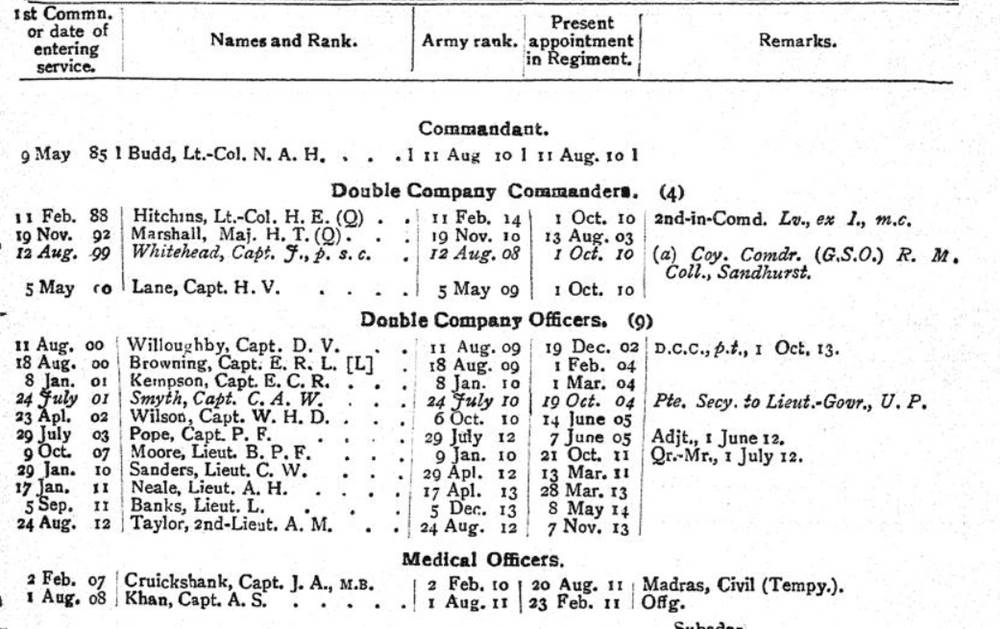This article is about the 1st Brahmans and will help you to research the Regiment and those who served with it during the First World War. I have written a separate article for the war-raised 2nd Battalion 1st Brahmans and a series of guides to researching soldiers who served in the Indian Army:
The 1st Brahmans in the First World War
Lineage: Raised by Captain T. Naylor at Oudh in 1776, for service with Nawab Wazir. Transferred to the Honourable East India Company’s service in 1777 as the 30th Battalion of Bengal Sepoys. In 1781 became the 23rd Regiment of Bengal Sepoys, the 29th Regiment in 1784, the 29th Bengal Sepoy Battalion in 1786, the 29th Sepoy Battalion in 1786, the 2nd Battalion, 9th Regiment of Bengal Native Infantry in 1796 and the 21st Regiment of Bengal Native Infantry in 1824. In 1861, the 1st Regiment of Bengal Native Infantry, then in 1885 1st Regiment of Bengal Infantry. In 1901 the Regiment was designated the 1st Brahman Infantry, in 1903 the 1st Brahmans and in 1922 became the 4th Battalion, 1st Punjab Regiment.
Class Composition of Battalion in 1914: 8 Companies of Brahmans 1919: 4 Companies of Brahmans.
Location in August 1914: The 1st Brahmans was stationed at Bolarum, Hyderabad, having arrived from Jubbulpore, present-day Jabalpur on 3 March 1910.
The 1st Brahmans was an Indian infantry regiment which saw service in India and Aden during the First World War. In 1914, the 1st Brahmans was serving as part of the 1st Secunderabad Infantry Brigade in the 9th (Secunderabad) Division. This Division remained in India for the duration of the war. In its last confidential report for the outbreak of war, the inspecting officer Major-General Percival Spearman Wilkinson, who commanded the Secunderabad Brigade gave the Regiment a good report. Many of the categories, from Turn-out, to Musketry and Physique received the grade “Very satisfactory” and Wilkinson reported the unit “Quite fit” for active service. Major-General Arthur Phayre, who commanded the Division wrote
A fine well set up lot of men. The improvement of musketry is very creditable. The regiment is efficient all round, and quite fit for active service.
Confidential review reports on Indian Army units for 1913-1914: IOR/L/MIL/7/17023.
The Regiment joined the Peshawar Infantry Brigade in November 1914, as part of the 1st (Peshawar) Division. Unfortunately, there is no war diary for the Regiment and few resources to consult. In May 1915, the 1st Brahmans had all eight of its companies at Peshawar with detachments at Abazai, Cherat and Jamrud. By the end of the year, the Regiment had six of its companies at Kila Drosh, two at Chitral and a detachment at Changla Gali. The unit was now serving with the Jhelum Brigade of the 2nd (Rawalpindi) Division. Its Depot was at Jhelum. In August 1916, the 1st Brahmans was still in these positions. By February 1917, the Regiment had been reorganised on a four company basis, with three at Kila Drosh and one at Chitral. It was still part of the Jhelum Brigade of the 2nd (Rawalpindi) Division.
In October 1917, the 1st Brahmas was stationed at Santa Cruz, India where it was serving as part of the Poona Division. A 2nd Battalion 1st Brahmans was formed at Sitapur on 26 November 1917 and the original unit became the 1st Battalion 1st Brahmans. The 1st Battalion moved to Aden in February 1918 and served there for the remainder of the war. While at Aden the 1st Brahmans’ Depot was at Fatehgarh. In 1922 the 1st Brahmans became the 4th Battalion, 1st Punjab Regiment. The extract below was taken from the October 1914 Indian Army List and shows British officers serving with the Regiment as well as Captain A. S. Khan, who was the unit’s Indian Medical Officer.
War Diaries for the 1st Brahmans
Unfortunately, there are no war diaries for the 1st Brahmans.
Further Sources for the 1st Brahmans
The Indian Army List should be consulted for information regarding British and Indian officers who served with the 1st Brahmans. The Confidential Reports of the Regiment are held at the British Library and include brief annual reports for the British officers. However, when the Regiment was abroad only its Depot and the British officers serving there were reported on.

